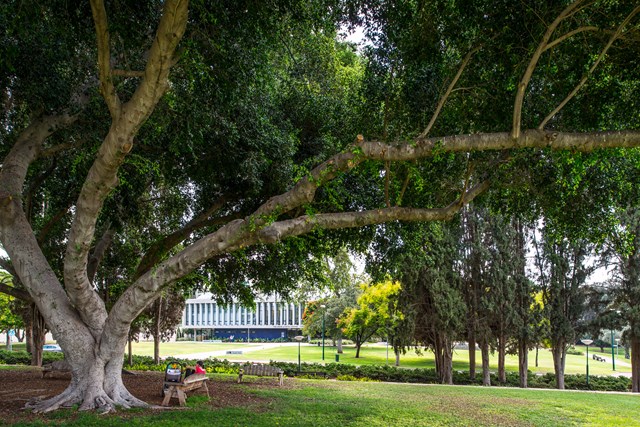Take a moment to literally be a tree hugger
Just one view of the mighty and diverse trees on the Weizmann Institute campus. Credit: Matthew Roberts
All species of holidays get absorbed into the culture at large – and one that you might want to start celebrating is the Jewish holiday of Tu B’Shvat: New Year of the Trees.
After all, what would life be without trees? Besides likely nonexistent, since we need them for food, wood, climate regulation, ecosystem creation and maintenance, etc., it would be awfully bleak. Who hasn’t gone dreamy in drifts of cherry blossoms, or been grateful for the shade of an oak in August, or gained perspective among giant redwoods, or realized that an apple straight from the tree was the best thing you’ve ever tasted?
Rites of spring seem to exist in every ancient culture. Tu B’Shvat, which dates to the Middle Ages, was originally such an observance; today, however, it’s been resurrected as an occasion to raise environmental awareness and, of course, plant trees. It’s even called “Israel’s Arbor Day.”
Find out what kind of tree you are with this quiz from Israel21c. The Curiosity Review is a pomegranate! We’re good with that.
This year, Tu B’Shvat was January 30-31, sunset to sunset. Not that we needed an excuse to eat these things, but it’s traditional to celebrate with a feast of fruits and vegetables, including tree foods like figs, olives, and pomegranates.
Such life-giving trees are so important that one of our scientists, Dr. Tamar Klein, is aiming to develop varieties of lemon, almond, and olive that are drought-resistant. These trees would be highly beneficial to arid countries that can’t currently grow them, helping feed an expanding world – and helping prepare for the hotter, drier times to come.
Whether in dry climates or wet, we need to take care of our trees so that they can take care of us. Rainforests are threatened due to pollution and deforestation – yet these unique ecosystems are crucial to life. That’s why understanding them in all their overheated, humid glory is also crucial. Fortunately, Weizmann scientists are on this, too!
Prof. Ilan Koren, collaborating with NASA and colleagues in Brazil, the U.K., and the U.S., discovered that a single valley in Africa provides more than half of the minerals that fertilize the Amazon region. Great nutrient-carrying dust clouds from northern Chad’s Bodélé Valley cross the ocean to feed the Amazon rain forest, keeping it from becoming a largely lifeless desert.
So go hug some trees. Or hold a feast in their honor. Or at least silently thank them. They deserve it.
[On a side note: Weizmann’s campus is rightfully known for its stunning gardens, allées, and diversity of trees; in fact, due to popular demand, the Institute now provides tours of its plant life. There is even a book featuring 100 individual trees. If you’d like to visit the campus the next time you’re in Israel, let us know.]



